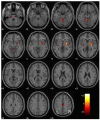Activation of the pre-supplementary motor area but not inferior prefrontal cortex in association with short stop signal reaction time--an intra-subject analysis
- PMID: 19602259
- PMCID: PMC2719646
- DOI: 10.1186/1471-2202-10-75
Activation of the pre-supplementary motor area but not inferior prefrontal cortex in association with short stop signal reaction time--an intra-subject analysis
Abstract
Background: Our previous work described the neural processes of motor response inhibition during a stop signal task (SST). Employing the race model, we computed the stop signal reaction time (SSRT) to index individuals' ability in inhibitory control. The pre-supplementary motor area (preSMA), which shows greater activity in individuals with short as compared to those with long SSRT, plays a role in mediating response inhibition. In contrast, the right inferior prefrontal cortex (rIFC) showed greater activity during stop success as compared to stop error. Here we further pursued this functional differentiation of preSMA and rIFC on the basis of an intra-subject approach.
Results: Of 65 subjects who participated in four sessions of the SST, we identified 30 individuals who showed a difference in SSRT but were identical in other aspects of stop signal performance between the first ("early") and last two ("late") sessions. By comparing regional brain activation between the two sessions, we confirmed greater preSMA but not rIFC activity during short as compared to long SSRT session within individuals. Furthermore, putamen, anterior cerebellum and middle/posterior cingulate cortex also showed greater activity in association with short SSRT.
Conclusion: These results are consistent with a role of medial prefrontal cortex in controlled action and inferior frontal cortex in orienting attention. We discussed these findings with respect to the process of attentional monitoring and inhibitory motor control during stop signal inhibition.
Figures



References
-
- Logan GD. On the ability to inhibit thought and action: A user's guide to the stop signal paradigm. In: Dagenbach D, Carr TH, editor. Inhibitory Processes in Attention. Memory and Language, Academic Press, San Diego; 1994. pp. 189–239.
Publication types
MeSH terms
Grants and funding
LinkOut - more resources
Full Text Sources

